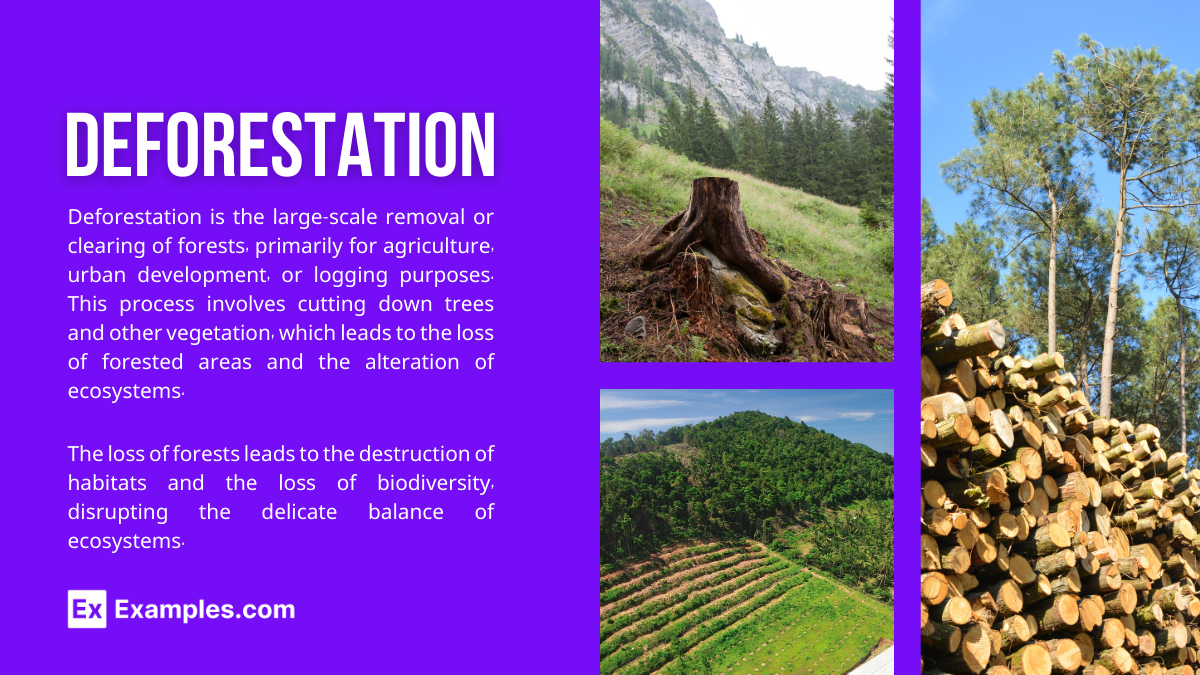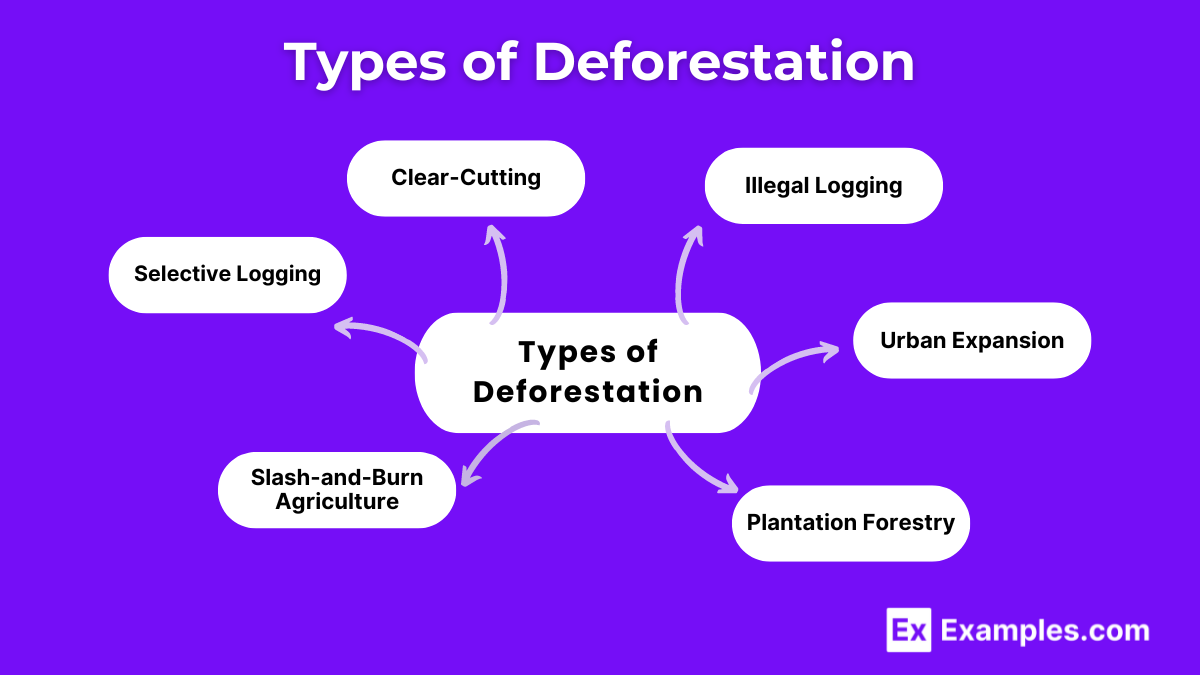What is the primary cause of deforestation worldwide?
Urbanization
Agriculture expansion
Natural disasters
Wildlife conservation


Deforestation is the large-scale removal of forests, leading to numerous environmental issues. This practice involves clearing trees and vegetation for agriculture, urban development, and logging. As forests disappear, the balance of ecosystems gets disrupted, impacting wildlife, climate, and human communities. Deforestation accelerates climate change by increasing carbon dioxide levels in the atmosphere. It also causes soil erosion, loss of biodiversity, and water cycle disruption. Understanding the causes, effects, and solutions to deforestation is crucial for sustainable environmental management.
Deforestation is the large-scale removal or clearing of forests, primarily for agriculture, urban development, or logging purposes. This process involves cutting down trees and other vegetation, which leads to the loss of forested areas and the alteration of ecosystems.

Deforestation occurs in various forms, each with distinct causes and impacts. Here are the main types:
Modern deforestation refers to the large-scale clearing of forests, primarily driven by human activities. This process has significant environmental, social, and economic impacts. Here’s an overview of the key aspects:
Deforestation has profound and far-reaching effects on the environment, biodiversity, climate, and human societies. Here are some of the most significant impacts:
Deforestation is driven by a combination of economic, social, and environmental factors. Here are some of the primary causes:
Deforestation leads to significant ecological and environmental issues, the most critical being the loss of biodiversity. Forests are home to over 80% of terrestrial species; their removal disrupts habitats, pushing many species toward extinction. This loss of biodiversity destabilizes ecosystems and reduces their resilience against environmental changes. Additionally, deforestation contributes to climate change by releasing stored carbon dioxide into the atmosphere, exacerbating global warming. It also affects local communities, especially indigenous peoples who rely on forests for their livelihoods, and disrupts the water cycle, leading to issues like soil erosion and decreased water quality.
Deforestation primarily affects indigenous communities, biodiversity, and the global climate. Indigenous peoples, who depend on forests for their livelihoods, culture, and identity, face displacement and loss of resources. Biodiversity suffers as numerous plant and animal species lose their habitats, leading to decreased ecosystem stability and potential species extinctions. The global climate is impacted by increased carbon dioxide emissions from deforestation, contributing to climate change and altering weather patterns, which in turn affect agricultural productivity and water availability worldwide.
Countries gaining forest cover are primarily found in temperate and high-income regions, where reforestation and afforestation initiatives are more feasible and economically supported. For instance, China has made significant progress through large-scale tree-planting programs. European countries like France and Spain have also seen forest growth due to natural reforestation and conservation efforts.
Conversely, tropical countries are experiencing the most significant forest loss due to agricultural expansion, logging, and infrastructure development. Brazil, with its vast Amazon rainforest, has faced severe deforestation driven by cattle ranching, soy cultivation, and illegal logging. Indonesia has also seen extensive deforestation, primarily for palm oil plantations. Other countries in Southeast Asia and Africa, like Malaysia and the Democratic Republic of the Congo, are similarly losing forests at alarming rates due to economic pressures and weak enforcement of environmental regulations.
Deforestation rates vary by region and year, but global estimates provide a general sense of the scale. According to data from the Food and Agriculture Organization (FAO) of the United Nations:
However, deforestation continues to be a major environmental concern, particularly in tropical regions such as the Amazon, Southeast Asia, and Central Africa. The primary drivers of deforestation include agriculture, logging, and infrastructure development.
Addressing deforestation requires a multi-faceted approach that includes both preventative measures and restorative actions. Key solutions include:
Text prompt
Add Tone
10 Examples of Public speaking
20 Examples of Gas lighting
What is the primary cause of deforestation worldwide?
Urbanization
Agriculture expansion
Natural disasters
Wildlife conservation
Which of the following is a direct consequence of deforestation?
Increased biodiversity
Enhanced soil fertility
Climate change
Improved air quality
What role do forests play in maintaining the water cycle?
They reduce rainfall
They enhance evaporation
They promote groundwater recharge
They prevent river flow
Which region is most affected by deforestation due to logging activities?
Arctic tundra
Tropical rainforests
Deserts
Grasslands
How does deforestation impact wildlife?
It increases animal populations
It creates more habitats
It leads to habitat loss
It has no effect on wildlife
What is one method used to combat deforestation?
Encouraging illegal logging
Reforestation
Expanding agricultural land
Increasing fossil fuel use
Which international agreement aims to reduce deforestation and promote sustainable land use?
Kyoto Protocol
Paris Agreement
Convention on Biological Diversity
United Nations Framework Convention on Climate Change
What is the impact of deforestation on soil erosion?
It decreases soil erosion
It has no impact
It increases soil erosion
It improves soil stability
Which of the following is a social impact of deforestation?
Improved health outcomes
Displacement of indigenous communities
Increased job opportunities in agriculture
Enhanced education access
How can individuals help reduce deforestation?
By purchasing products from unsustainable sources
By supporting reforestation initiatives
By ignoring conservation efforts
By increasing plastic use
Before you leave, take our quick quiz to enhance your learning!

